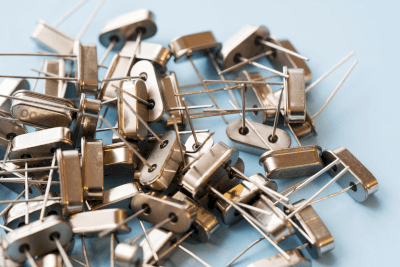What Is a Quartz Crystal Unit?

A Quartz Crystal Unit is a passive element that vibrates at a constant frequency, known as a piezoelectric element. Initially, natural crystals were used, but due to increased demand, artificial crystals have become more common, utilizing materials such as silicon dioxide, barium titanate, and Rochelle salt.
When integrated with oscillation circuits, piezoelectric elements are essential in electronic devices like mobile phones, televisions, digital cameras, household appliances, and in automotive and medical equipment. The quartz crystal’s thickness and cutting method are tailored to the desired frequency range. For example, the “AT cut” method produces a quartz crystal unit suitable for a broad temperature range, with frequencies ranging from 1 to 300 megahertz.
Principle of Quartz Crystal Unit
A piezoelectric crystal generates a surface charge proportional to the applied pressure in a specific direction, a phenomenon known as the piezoelectric effect. Conversely, applying voltage causes deformation, referred to as the inverse piezoelectric effect. While natural crystals were initially used, artificial crystals, such as silicon dioxide and potassium titanate, are now preferred to meet increased demand.
Quartz crystals have electrodes attached, allowing for external current flow. The surface charge of the quartz crystal unit changes periodically in response to the current phase, leading to periodic deformation.
Uses of Quartz Crystal Unit
Quartz crystal units are widely used in various household electronic devices like mobile phones, televisions, digital cameras, and computers, due to their stable and minimal frequency fluctuations. They are also integrated into automobiles and medical equipment. Quartz crystal-based oscillation circuits are highly precise, exhibiting accuracy in the ppm (parts per million) range.
Commonly, quartz crystal units are extremely thin, ranging from 20 to 50 micrometers in thickness. Electrodes are attached to the plate surface for connection with external terminals. The thickness and cutting surfaces of the crystal can be adjusted based on the desired functions of the quartz crystal unit.
Frequency of Quartz Crystal Unit
The frequency of quartz crystal units varies with the crystal’s cutting method and thickness. Thinner crystals are used for higher frequencies, while thicker crystals suit lower frequencies. For instance, the “AT cut” method can produce units for a wide temperature range with frequencies from 1 to 300 megahertz.
Other cutting angle variations, like the “BT cut,” cover the frequency range of 7 to 38 megahertz, differing in frequency stability compared to the AT cut. Fork-shaped crystals are typically used in timekeeping applications, supporting frequencies of 32.768 kilohertz.
Load Capacitance
When integrating a quartz crystal unit into a circuit, matching the load capacitance of the circuit with that of the quartz crystal unit is crucial. Load capacitance, viewed from the quartz crystal unit to the oscillation circuit, is the virtual equivalent static capacitance value in series. To stabilize the circuit against changes in load capacitance, it’s necessary to choose a quartz crystal unit with an appropriate load capacitance value.
In practical applications, adjustments are made based on the oscillation frequency, allowable deviation, and the quartz crystal unit’s load capacitance values. However, due to various factors in real circuits, there is floating capacitance, leading to a deviation between the circuit’s oscillation frequency and the standard load capacitance frequency. Adjustments involve determining the difference between these frequencies and fine-tuning the circuit’s static capacitance to minimize this difference.